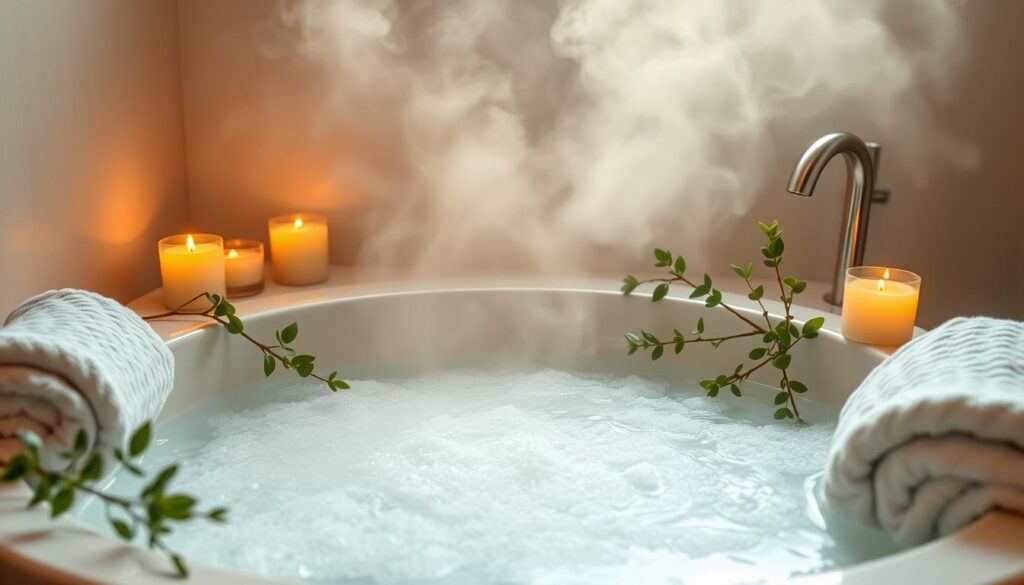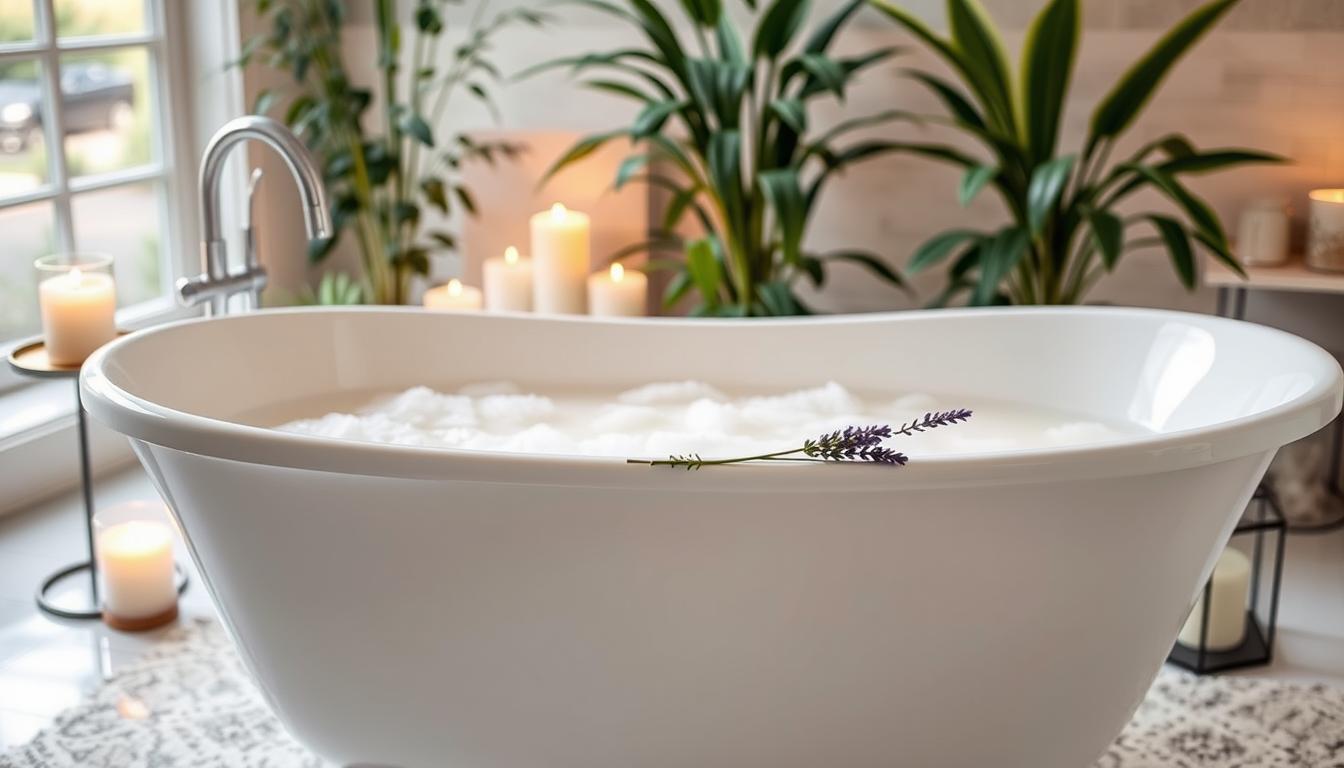Ever thought about a natural way to ease yeast infection discomfort? Look no further than Epsom salt baths. Yeast infections, or candidiasis, affect people of all genders. They can be caused by antibiotics, pregnancy, diabetes, and a weak immune system.
These infections mainly hit the vagina but can also affect the mouth, skin, and other areas. Soaking in an Epsom salt bath for 15-20 minutes can help ease symptoms. It offers a soothing, natural solution.
But did you know Epsom salt baths also boost vaginal health? Let’s dive into the science behind this remedy. We’ll see how it can balance your pH, reduce inflammation, and aid in healing.
Key Takeaways
- Epsom salt baths can provide natural relief for yeast infection symptoms
- Epsom salt has anti-inflammatory properties that can soothe irritated tissue
- Epsom salt baths can help restore the vaginal pH balance
- Combining Epsom salt with other natural ingredients can enhance the benefits
- Epsom salt baths are a safe and effective way to support the healing process
Understanding Yeast Infections: Causes and Symptoms
Vaginal yeast infections, also known as feminine hygiene issues, are common. They happen when Candida albicans fungus grows too much in the vagina. These infections are not usually serious but can be very uncomfortable.
Common Symptoms of Vaginal Yeast Infections
The main signs of a vaginal yeast infection are:
- Intense itching or irritation in the vaginal area
- Thick, white, clumpy vaginal discharge, often described as resembling cottage cheese
- Redness and swelling of the vulva
- Burning sensation, especially during intercourse or while urinating
Risk Factors and Triggers
Some things can make you more likely to get a vaginal yeast infection or make it come back. These include:
- Antibiotic use, which can disrupt the natural balance of vaginal bacteria
- Hormonal changes, such as those experienced during pregnancy or with birth control
- Weakened immune systems, often due to conditions like HIV/AIDS or cancer treatments
- Uncontrolled diabetes, which can lead to elevated glucose levels that promote yeast growth
- Wearing tight, synthetic clothing that doesn’t allow for proper airflow and moisture management
When to Seek Medical Attention
If your symptoms of a vaginal yeast infection don’t get better or get worse, see a doctor. A healthcare provider can figure out what’s wrong and suggest the best holistic yeast infection cure.
While home remedies and over-the-counter treatments can help a bit, they might not work for everyone. If you keep getting yeast infections, you might need prescription medicine. Getting help from a doctor is the best way to fix your feminine hygiene problems for good.
The Science Behind Epsom Salt Bath for Yeast Infection
Dealing with a yeast infection can be tough. But, an Epsom salt bath might offer some relief. Epsom salt, or magnesium sulfate, has anti-inflammatory properties. These can help soothe irritated vaginal tissues.
It may also help balance the vaginal pH. This makes it harder for yeast to grow too much.
Epsom salt baths aren’t a cure for yeast infections. Yet, they can help with symptoms and support healing. Studies show they work best when used with other treatments.
A 2015 study found a big improvement in yeast infection treatment. It showed an 89% cure rate when using Epsom salt baths with other treatments. This is compared to a 70% cure rate with just medication.
Epsom salt baths offer more than just relief from yeast infections. They can also help with inflammation, joint and muscle health, and sleep. Topical magnesium from Epsom salt can enter the skin. This may increase magnesium and sulfate levels in the body.
| Natural Remedy | Effectiveness in Treating Yeast Infections |
|---|---|
| Boric acid | Cured 40% to 100% of patients in a 2011 study |
| Greek yogurt and honey | As effective as clotrimazole cream in a 2015 study |
| Oregano oil capsule | Effective against certain strains of infections |
Epsom salt baths may not cure yeast infections. But, they can ease symptoms like irritation, itching, redness, and swelling. Used with prescribed treatments, they can speed up recovery and support vaginal health.
Remember, Epsom salt baths shouldn’t replace medical treatment for yeast infections. If symptoms get worse, seek medical advice. Also, be careful not to take too much Epsom salt or have an allergic reaction.
Benefits of Using Epsom Salt for Vaginal Health
Epsom salt is a natural compound with magnesium and sulfate. It has many benefits for vaginal health. Its anti-inflammatory properties can reduce swelling and irritation. This helps those with yeast infection or other vaginal issues find relief.
Restoring pH Balance
The vagina needs a delicate pH balance, between 3.8 and 4.5. This acidic environment keeps harmful bacteria and yeast in check. Epsom salt helps restore this balance, making it harder for yeast infections to thrive.
Soothing Irritated Tissue
Adding Epsom salt to warm water can soothe irritated vaginal tissues. It offers relief from itching, burning, and discomfort. These are common symptoms of yeast infections or other vaginal conditions.
Anti-Inflammatory Benefits
Epsom salt’s anti-inflammatory properties can reduce swelling and inflammation. This is great for those with irritation, redness, or soreness. These symptoms are often seen in yeast infections or other vaginal issues.
Using Epsom salt in your self-care routine can support your vaginal health. It helps find relief from yeast infections and other common vaginal concerns.
How to Prepare the Perfect Epsom Salt Bath
Epsom salt baths are a natural way to ease yeast infection symptoms. To make the perfect bath, just follow these easy steps:
- Fill your bathtub with warm water, aiming for 90°F to 105°F for best results.
- Add 1-2 cups of Epsom salt to the water and stir until it’s fully dissolved.
- Soak in the bath for 10-15 minutes. But don’t stay longer to avoid skin irritation.
- After the bath, gently pat the area dry with a clean towel.
For a more focused treatment, try a sitz bath. It lets you soak just the affected area in a smaller Epsom salt solution. This is especially good for vaginal yeast infections.
| Epsom Salt Bath Benefits | Potential Risks |
|---|---|
|
|
While Epsom salt baths can help with yeast infections, it’s key to follow the guidelines. Avoid overusing them to prevent any bad side effects.

Enhancing Your Bath with Natural Ingredients
An Epsom salt bath can soothe a yeast infection. But, you can make it even better with natural ingredients. Adding healing herbs like plantain, linden, and yarrow to your bath is a gentle way to fight fungal infections.
Healing Herbs and Essential Oils
Plantain is a weed with anti-inflammatory and antimicrobial properties. It’s great for soothing irritated skin and supporting vaginal health. Linden flowers calm the body and help balance pH levels. Yarrow fights fungal infections and reduces inflammation.
Essential oils, like tea tree oil, are also good for treating yeast infections. Tea tree oil is a natural antifungal that can help fight Candida yeast.
Therapeutic Combinations
Blending Epsom salts with herbs and essential oils can make your bath more restorative. Smoketree Massage and Apothecary’s Beaver Reliever Yeast Infection Sitz Bath combines these ingredients. It targets vaginal discomfort, pain, and itching from yeast infections.
Introducing Beaver Reliever Sitz Bath
The Beaver Reliever Sitz Bath is a special solution for yeast infections. It uses natural ingredients to soothe and restore vaginal health. With Epsom salts, healing herbs, and essential oils, it offers a holistic way to manage yeast infection symptoms.
“Baking soda baths may help to relieve symptoms of various conditions such as yeast infections, diaper rash, eczema, poison ivy and poison oak rashes, psoriasis, detoxification, chickenpox, urinary tract infections (UTIs), vulvar vestibulitis, and constipation.”
Additional Natural Remedies to Support Treatment
Consider other natural remedies to help with your vaginal yeast infection. Probiotics, especially Lactobacillus strains, can balance your vaginal flora. You can try eating Greek yogurt with live cultures or applying it directly.
Boric acid suppositories are also worth looking into. Studies suggest they can help with persistent or recurring yeast infections. But, always talk to your healthcare provider before trying new treatments, especially if you’re pregnant or have recurring infections.
| Natural Remedy | Benefits |
|---|---|
| Probiotics | Help restore vaginal flora balance |
| Greek Yogurt | Topical or ingested, may provide relief |
| Boric Acid Suppositories | Effective for persistent or recurring infections |
While these natural remedies can help, it’s best to talk to a healthcare professional. They can offer personalized advice and ensure you get the right home remedy for yeast infections.

“Maintaining a healthy, balanced vaginal environment is key to preventing and managing yeast infections. Incorporating natural remedies alongside medical treatment can be a powerful approach.”
Prevention and Lifestyle Changes
Keeping a healthy lifestyle can help prevent feminine hygiene problems like candida overgrowth treatment. Here are some important steps to follow:
Dietary Considerations
Eat foods low in sugar and high in probiotics. Foods with lots of sugar and carbs can make Candida grow, causing yeast infections. Add probiotic-rich foods like yogurt, kefir, and fermented veggies to your diet. They help keep your gut flora balanced.
Hygiene Best Practices
Don’t use harsh soaps, scented products, or douching. These can upset the vagina’s pH balance. Use gentle, unscented cleansers and choose cotton-based products. Wash the outside of your genital area with warm water every day.
Clothing Recommendations
Wear loose, breathable fabrics like cotton for underwear. Avoid tight clothes that trap moisture and heat, which yeast likes. If you keep getting infections, try cotton underwear and avoid synthetic fabrics.
Staying healthy, drinking plenty of water, and managing stress are key to avoiding feminine hygiene issues. If you have diabetes, controlling it can also help prevent candida overgrowth treatment.
By following these preventive steps, you can protect your intimate health and reduce yeast infection problems.
Conclusion
Epsom salt baths are a natural way to ease yeast infection symptoms. They don’t cure the infection alone but offer relief. Adding them to your routine can help your vaginal health.
Using epsom salt baths for yeast infection is part of a bigger plan. It’s about using natural remedies and making lifestyle changes. This approach helps manage and prevent yeast infections.
It’s important to use natural antifungal baths regularly. Keeping clean and eating right also helps. If your symptoms don’t go away, see a doctor for help.
Adding Epsom salt baths to your self-care can help your vaginal health. It’s a step towards feeling better. Try Epsom salts and other natural remedies. Your body will appreciate the care.

